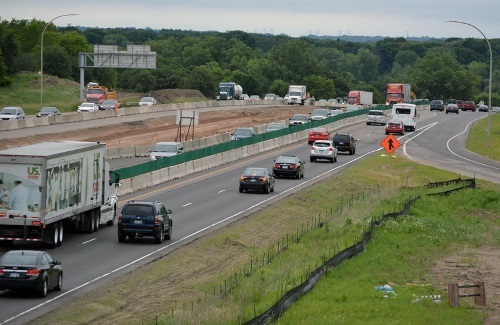During the annual meeting of the American Association of State Highway and Transportation Officials Committee on Safety – held virtually from May 11 through 14 due to the COVID-19 pandemic – a panel discussion focused on how changing human behaviors is one key to the success of the Toward Zero Deaths program.
[Above photo by the Minnesota DOT.]
“It all comes down to the decisions people make behind the wheel; that’s why we need to get a handle on human behavior decision-making,” explained Katie Fleming-Vogl, senior research analyst and project manager at Minnesota Department of Transportation.

“What we’re doing now is analyzing behaviors that help us identify what actions will result from them,” she said. “That’s critical to successful safety culture implementation. For example, if 96 percent of motorists in a community wear their seat belt, how do we reach the remaining 4 percent? Across the social ecology there are ways for everyone in the community to leverage traffic safety culture.”
Jonathan Nelson, traffic safety engineer with the Missouri Department of Transportation, said reaching that “unbuckled” segment of motorist is critical to improving overall traffic safety and achieving Towards Zero Deaths success.
“In Missouri, we are at 88 percent seat belt usage right now,” he explained. “That’s great, but the problem is those 12 percent who don’t buckle up represent about 70 percent of our highway fatalities.”

That’s why changing driver behaviors is the key to improving overall traffic safety. “Distracted driving is tricky when it comes to reporting data. But we do know it is the fastest growing contributor to crashes in Missouri and more times than not it is someone else in the vehicle being killed other than the distracted driver,” Nelson said. “Also we cannot ignore the impact of speeding or aggressive driving – indeed, speed is top contributor to crash deaths. And then there is impaired driving, which is responsible for 20 percent of highway fatalities.”
As a result, Missouri is “trying to get everyone and anyone to do something” to change the traffic safety culture, he pointed out, with the Missouri DOT focused on developing a more “grass-roots” level of engagement.
“A lot of this has to do with changing the traffic safety culture: we need to understand this is a problem and that nearly all of those crashes are preventable,” Nelson explained. “It is early still but we are seeing promising results. For example, seat belt use is now up 6.3 percent in 2.5-year period. We now have 65 municipalities – representing just under 30 percent of Missouri’s population – that have passed primary seat belt laws on their own. This has really been an across-the-board effort.”

That also dovetails with a key emphasis area of Patrick McKenna – MoDOT’s director – as he has made highway safety a critical focus area for his one-year term as AASHTO’s 2019-2020 president; continuing the organization’s role in the Towards Zero Deaths and Vision Zero national coalitions while “facilitating a conversation” with member state DOTs and local communities to consider ways to deploy “innovative infrastructure designs and technologies” to more safely accommodate pedestrians, bicyclists, and scooter users.
That includes continuing to promote his agency’s Buckle Up, Phone Down challenge both at the local level within Missouri and among fellow state DOTs as well.

Jason Siwula, assistant state highway engineer for innovation at the Kentucky Transportation Cabinet, pointed out during the session that forming more “multi-discipline partnerships” between transportation, law enforcement, and public health agencies is another key factor that will help improve a state’s overall traffic safety culture.
“We’re really looking for a more holistic approach to safety, and not just for increasing seat belt use but for ALL of our safety issues,” he emphasized. “It is interesting when you think about the difference between preventing what happens tomorrow versus reducing what happened yesterday. It will take everyone thinking differently to change tomorrow’s outcome. That’s why partnerships with public health agencies are important place to start; it offers a two-way opportunity for transportation agencies.”

Ashley Bush, senior data management specialist with the University of Kentucky, explained that there are “many opportunities and commonalities between transportation and public health agencies as both disciplines affect everyday life.”
“One of the most direct connections is motor vehicle injuries and deaths. Public health agencies have surveillance data regarding motor vehicle injury and death information that we can share with transportation agencies.,” Bush noted. “Traditionally, that involved two separate approaches – but by merging those two approaches together helps expand outreach efforts.”
Bush explained that public health agencies have access to data sources not necessarily utilized by transportation, such as hospitalization and billing data. “That data can help create motor vehicle risk ‘hot spots’ – and that injury surveillance can help improve the health of communities by reducing death and injuries associated with motor vehicle crashes, as they are the leading cause of unintentional injury/death among 15 to 24 year olds.”
“By using this combined approach, we’re not just looking at where a crash happens – we’re looking at it in relation to where people live at a group level and how it impacts their community,” KYTC’s Siwula said. “It’s talking about safety at the local level, where it impacts people more directly than from a statewide perspective.”



